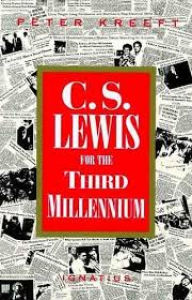An Amazon Link to:
==> C.S. Lewis for the Third Millennium <==
—————————————————-
In his introduction Kreeft tells us that:
In our senile, toothless, and confused culture stumbles blindly towards the third millennium; as our “century of genocide” comes to an end, having murdered more human beings (more born and unborn) in a single century than the total of all men who lived in all previous centuries; as our demonic “culture of death” accelerates in shark like feeding frenzy of the human bodies and souls; and as our arrogant and impenitent planet rushes naked and defenseless through space and time on a collision course with the fearsome heavenly body of the justice of God, we wonder: “what next?”—and even whether there will be a “next”. For we look for prophets. I believe two of the most prophetic books of our century are Aldous Huxley’s Brave New World and C.S. Lewis’ Abolition of Man. If you want to see the third millennium, read these two books. Lewis has one great advantage over Huxley: he is a Christian. Therefore he holds out hope, appeals to moral choice, and offers a positive alternative, though his jeremiad is no less horrific than Huxley’s scenario of doom. But the hope, the later alternative, and the choice are not limited to Christians. The spiritual war of this century is not among different religions but between all religions and none. That is why what is happening in Bosnia (Kreefts’ book was published in 1994) and Northern Ireland is not merely wicked, it is hopelessly out-of-date; a civil war breaking out in the ranks during a global and apocalyptic war against Hell. The Abolition of Man appeals to all men of good will and sound mind. So does this book: six essays about The Abolition of Man applied to our time and our future:
The first essay, “How to Save Western Civilization: C.S. Lewis as Prophet,” summarizes Lewis’ philosophy of history.
The second, “Darkness at Noon: The Eclipse of ‘The Permanent Things”, summarizes our era from the standpoint of this philosophy.
The third, “The Goodness of Goodness and the Badness of Badness”, is a defense of the Nature law, or objective values as the absolute sine qua non for the survival of civilization, and a summary of Lewis’ refutation of the twenty alternatives to it.
The fourth, “Can the Natural Law Ever Be Abolished from the Heart of Man?”, puts Lewis in dialogue with Saint Thomas Aquinas on whether the abolition of man (i.e., man as moral) can ever happen.
The fifth, “Walker Percy’s Lost in the Cosmos: The Abolition of Man in Late-Night-Comedy Format”, is some comic relief on the same heavy topics treated in chapters 1 through 4.
And the sixth, “The Joyful Cosmology: Perelandra’s ‘Great Dance’ As an Alternative Worldview to Modern Reductionism”, fleshes out Lewis’ hopeful conclusion in The Abolition of Man: a new and humane world view of cosmology that is the necessary background for the new life view or morality. The newness is a restoration of the old. When radicalism is the establishment, the only really revolution is traditionalism.
The six essays are literally “essays”, the explorations—into the single most momentous question of our desperate times. I invite the reader to join me on my six little rafts following the wake of Lewis’ pioneering ship to explore the whirlpool and rapids of this great, roaring river that is our common culture, now apparently headed for the falls. Whether and how it is possible to avert this fate is one of the few really relevant things to think about today. Take a look at => Culture Watches’ review of Kreeft’s C.S. Lewis for the Third Millennium.
——————————————————————————–
The Imagination
—————————————–
Lewis and Tolkien: G.K. Chesterton, Myth, and the Imagination
———-
———————————————————————-
If you’re interested in hearing a very elaborate description of the specific ways in which the imagination came into play in Lewis’ writings click on this link to hear the Malcolm Guite Lecture (it’s the second lecture in the series) given at the Westminster Abbey Institute for The C.S. Lewis Symposium which commemorated the fiftieth anniversary of Lewis’ death.
—————————————
